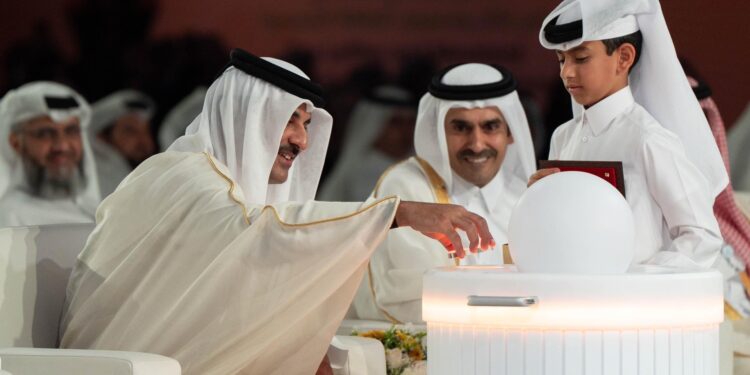Doha- Qatar opened today, Monday, the two heads of Ras Luvan and Mieed solar energy with a total production capacity of 875 megawatts of electricity, as part of the work to diversify its economic resources and expand in the field of clean energy.
Today, the Emir of Qatar, Sheikh Tamim bin Hamad Al Thani, launched the two stations that are expected to increase the production capacity of solar energy plants in the State of Qatar to 1675 megawatts of renewable electric energy.
The Emir of Qatar said in a post on his official account on the X platform.
In light of global climatic challenges, Qatar appears to be steadfast at a steady pace towards building a more flexible and friendly economy for the environment, putting clean energy at the center of its national strategies.
As part of our plans to shift towards renewable energy, today two strategic projects for solar energy in Ras Luvan and Mieid were launched today. We aim from these two stations to diversify energy resources, support our country’s strategic development projects, and to benefit from the capabilities of low carbon energy in our sustainability plans and reduce … pic.twitter.com/1zcn4aeqcq
– Tamim bin Hamad (@tamimbinhamad) April 28, 2025
Environmental protection
Saad bin Sheridah Al -Kaabi, Minister of State for Energy Affairs, Managing Director and CEO of Qatar Energy, said that the operation of the Ras Luvan and Mieid solar energy stations is a basic step towards achieving the fourth pillar of Qatar National Vision 2030, which is the environmental management in a way that guarantees the harmony and consistency between economic and social development and the protection of the environment, and also achieves one of the goals of Qatar Energy Strategy for Sustainability, which is to generate more than 4 thousand Megoat of renewable energy by 2030.
He added in his speech during the opening ceremony that building solar power plants is one of the most important initiatives of the country to reduce carbon dioxide emissions, develop sustainability projects, and diversify electrical energy production sources, expecting that these stations will reduce emissions by about 4.7 million tons annually.
The minister pointed out that the two stations will play, along with the concrete station, an important role in meeting the demand for electricity in the country, at a time when the three stations will contribute about 15% of the total demand for electricity in peak times and this percentage will rise to 30% after the operation of the Smoke Giant Smart Station by 2029, whose production capacity is about two thousand megawatts.
Al -Kaabi added that Qatar has exceeded the stage of relying on the experiences of others to build, operate and maintain solar stations, and began implementing these projects with its national experiences that are proud of their achievements.
– Qatarenergy (@qatarenergy) April 28, 2025
Reducing traditional energy dependence
In a statement to Al -Jazeera Net, economist Abdullah Al -Khater stressed that Qatar’s focus on clean energy, especially solar energy, is part of a comprehensive strategy aimed at reducing dependence on traditional sources of energy, such as oil and gas, and diversifying the country’s economic base.
He explained that solar energy is an inexhaustible source of energy, which gives it a major strategic advantage, and helps the state achieve its environmental and economic goals at the same time.
Al -Khater said that the incubator environment established by Qatar to support clean energy through stimulating legislation, investment in scientific research, and the establishment of huge solar energy projects, the most recent of which is the opening of the Ras Luvan and Mieesid solar energy stations in the city of Ras Lafan, plays a major role in consolidating the state’s status as a regional center for sustainable energy.
He added that these projects enhance Qatar’s productive capabilities in the electricity sector from clean sources, so this is reflected positively on national energy security and reduces pressure on traditional resources, explaining that investing in clean energy is not limited to achieving environmental sustainability, but also contributes to the liberalization of a large part of the energy used internally, which allows to direct oil and gas resources towards export, increase economic returns, and enhance the general budget of the state.
He said that this type of investment represents a real opportunity to create a more diverse and stable economy, and enhances the state’s ability to face global economic fluctuations associated with oil prices.
A total production capacity of 875 megawatts
His Highness the Emir of the country opens the two stations of Ras Luvan and Mieed solar energy#Qatar_Traft #Qatar pic.twitter.com/d0ECQNteis
– Qatarenergy (@qatarenergy) April 28, 2025
A more sustainable economy
Economist Abdul Rahim Al -Hour said, in an interview with Al -Jazeera Net, that the opening of the two heads of Ras Luvan and Mieed solar energy with investments amounting to 2.3 billion Qatari riyals (632 million dollars) is an important strategic step in the path of turning the State of Qatar towards adopting clean and renewable energy.
He added that “this positive trend towards diversification of energy sources reflects a high awareness of the importance of reducing energy production costs in the strategic term and enhancing the flexibility of the national economy in the face of global transformations.”
Al -Hour explained that this transformation embodies an ambitious Qatari vision towards building a more sustainable and diversified economy, which enhances Qatar’s position on the international scene as a leading country in the areas of clean energy and environmental protection.
He pointed out that the two stations depend on advanced techniques using high -efficient dual -faced solar panels, and mono -axis tracking devices, which contributes to increasing productivity and reducing losses, as well as using daily automatic cleaning robots to improve operational performance.
Source : Al Jazeera + Qatar News Agency (Qena)



